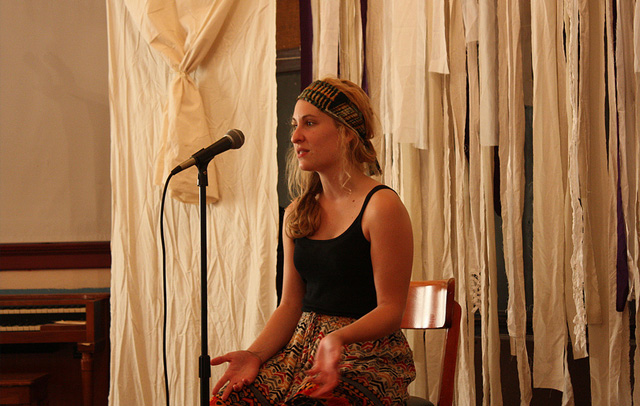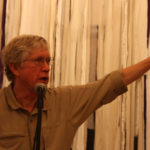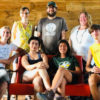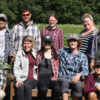The idea of a neighborhood can take many forms, from a dorm community to a country road to a typical suburban lane. We found all of these archetypes and more as we gathered on July 12 to tell stories at Huss, a building in its own neighborhood with its own neighbors and enough stories to fill even its cavernous halls. If you listen closely, preferably at night when the story ghosts are strong, you might even hear one or two. We heard nearly a dozen.
- Our first story involved the vandalism of a street sign by a spelling-conscious young lady; a woman whose convictions to see words rightly displayed overcame any reluctance she might have felt at tearing down a piece of city property.
- Next up was a visual story, a snaking map of overlapping roads depicting important neighborhoods in the artist’s life; a picture worth a thousand words and probably more.
- The third story was about pranks, and how a good-natured prank can help build the bonds of community just as well as a meaningful conversation or a shared experience.
- The fourth story was about a neighbor, an older man helping out a younger, less knowledgeable man with the vagaries of controlled burns; a cautionary tale that warned us to be wary when lighting fires because you might lose control and need to be saved.
- Our fifth story took place in the past, or at least in a re-enacted past on the East coast where history can seem both richer and more cruel, a place where the history of the Revolutionary and Civil Wars is as every bit as relevant as it was in its own time.
- The sixth story was about Three Rivers itself, and how important it is to come together and be neighbors, and tell stories and heal wounds. We learned through the storyteller’s eyes what it was like to grow up in Three Rivers, something the majority of us had never done.
- The seventh story felt like something from a Murakami novel, a surreal look into the differences of people’s lives when viewed from the alleyways behind their homes. We saw the difference between neighbors in Tuscon, who are forced to remain sheltered in their air conditioned lives, and neighbors in Three Rivers, who can often be found strolling along sidewalks, enjoying the often moderate climate.
- The eighth story told of a darker time in Detroit, when anger and heat came together to cause riots in the streets, fueled by racism and influential to a young man’s path to ministry.
- Our ninth story related to days of youthful judgement, and how parental choices in where to live can often be confusing until later in life when we’ve seen more of the story and can find understanding.
- The tenth story was one of loss, and how the absence of a parent can alter our lives and neighborhoods in incontrovertible ways. We saw in this story how even parents can be neighbors (particularly if they live in the apartment above your own).
- The last and final story told of foreign neighborhoods, and how different neighbors are in Peru compared to neighbors in Three Rivers. We learned that sometimes it can take more than a freshly baked pie to crack the shell of American privacy.
We will soon tell more stories. Our next storytelling night will be on August 9, and our stories will revolve around the theme, “When I Grow Up.” Join us at 7:00 p.m., bring a dish to pass, and tell us what you want to be when you grow up. All answers are acceptable.
Tags: neighborhoods, storytelling Last modified: March 4, 2020





